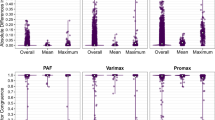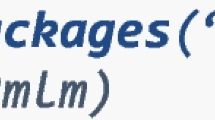Abstract
We provide a free noncommercial SPSS program that implements procedures for (a) obtaining the polychoric correlation matrix between a set of ordered categorical measures, so that it can be used as input for the SPSS factor analysis (FA) program; (b) testing the null hypothesis of zero population correlation for each element of the matrix by using appropriate simulation procedures; (c) obtaining valid and accurate confidence intervals via bootstrap resampling for those correlations found to be significant; and (d) performing, if necessary, a smoothing procedure that makes the matrix amenable to any FA estimation procedure. For the main purpose (a), the program uses a robust unified procedure that allows four different types of estimates to be obtained at the user’s choice. Overall, we hope the program will be a very useful tool for the applied researcher, not only because it provides an appropriate input matrix for FA, but also because it allows the researcher to carefully check the appropriateness of the matrix for this purpose. The SPSS syntax, a short manual, and data files related to this article are available as Supplemental materials that are available for download with this article.
Similar content being viewed by others
References
Basto, M., & Pereira, J. M. (2012). An SPSS R-Menu for ordinal factor analysis. Journal of Statistical Software, 46(4), 1–29.
Bollen, K. A., & Stine, R. A. (1992). Bootstrapping goodness-of-fit measures in structural equation models. Sociological Methods and Research, 21, 205–229.
Chen, J., & Choi, J. (2009). A comparison of maximum likelihood and expected a posteriori estimation for polychoric correlation using Monte Carlo simulation. Journal of Modern Applied Statistical Methods, 8, 337–354.
Choi, J., Kim, S., Chen, J., & Dannels, S. (2011). A comparison of maximum likelihood and Bayesian estimation for polychoric correlation using Monte Carlo simulation. Journal of Educational and Behavioral Statistics, 36, 523–549. doi:10.3102/1076998610381398
Courtney, R., & Gordon, M. (2013). Determining the number of factors to retain in EFA: Using the SPSS R-Menu v2.0 to make more judicious estimations. Practical Assessment, Research and Evaluation, 18(8), 1–13.
Devlin, S. J., Gnanadesikan, R., & Kettenring, J. R. (1975). Robust estimation and outlier detection with correlation coefficients. Biometrika, 62, 531–545.
Einspruch, E. L. (2003). Next steps with SPSS. Thousand Oaks, CA: Sage.
Ferrando, P. J. (2009). Difficulty, discrimination and information indices in the linear factor-analytic model for continuous responses. Applied Psychological Measurement, 33, 9–24.
Hall, P., & Martin, M. A. (1988). On bootstrap resampling and iteration. Biometrika, 75, 661–671.
Hofstee, W. K. B., Ten Berge, J. M. F., & Hendriks, A. A. J. (1998). How to score questionnaires. Personality and Individual Differences, 25, 897–909. doi:10.1016/S0191-8869(98)00086-5
Knol, D. L., & Berger, M. P. F. (1991). Empirical comparison between factor analysis and multidimensional item response models. Multivariate Behavioral Research, 26, 457–477. doi:10.1207/s15327906mbr2603_5
Lee, C.-T., Zhang, G., & Edwards, M. C. (2012). Ordinary least squares estimation of parameters in exploratory factor analysis with ordinal data. Multivariate Behavioral Research, 47, 314–339. doi:10.1080/00273171.2012.658340
Lorenzo-Seva, U., & Ferrando, P. J. (2012). TETRA-COM: A comprehensive SPSS program for estimating the tetrachoric correlation. Behavior Research Methods, 44, 1191–1196. doi:10.3758/s13428-012-0200-6
Lorenzo-Seva, U., & Ferrando, P. J. (2013). FACTOR 9.2: A comprehensive program for fitting exploratory and semiconfirmatory factor analysis and IRT models. Applied Psychological Measurement, 37, 497–498.
Lorenzo-Seva, U., & Ferrando, P. J. (2013b). Manual of the program FACTOR (Technical Report). Universitat Rovira i Virgili, Department of Psychology. Retrieved from http://psico.fcep.urv.cat/utilitats/factor/
McDonald, R. P. (1999). Test theory: A unified treatment. Mahwah, NJ: Erlbaum.
Muthén, B. (1993). Goodness of fit with categorical and other nonnormal variables. In K. A. Bollen & J. S. Long (Eds.), Testing structural equation models (pp. 205–234). Newbury Park, CA: Sage.
Norusis, N. J. (1988). The SPSS guide to data analysis for SPSS/PC+. Chicago IL: SPSS.
Olsson, U. (1979). Maximum likelihood estimation of the polychoric correlation coefficient. Psychometrika, 44, 443–460. doi:10.1007/BF02296207
Peters, C. C., & van Voorhis, W. R. (1940). Statistical procedures and the mathematical bases. New York, NY: McGraw-Hill.
Rigdon, E. E. (2010). Polychoric correlation coefficient. In N. Salkind (Ed.), Encyclopedia of research design (pp. 1046–1049). Thousand Oaks, CA: Sage.
Samejima, F. (1969). Estimation of latent ability using a response pattern of graded scores. Psychometrika(Monograph No. 17). Iowa City, IA: Psychometric Society.
Schenker, N. (1985). Qualms about bootstrap confidence intervals. Journal of the American Statistical Association, 80, 360–361.
Sievers, W. (1996). Standard and bootstrap confidence intervals for the correlation coefficient. British Journal of Mathematical and Statistical Psychology, 49, 381–396.
Vigil-Colet, A., Morales-Vives, F., Camps, E., Tous, J., & Lorenzo-Seva, U. (2013). Development and validation of the Overall Personality Assessment Scale (OPERAS). Psicothema, 25, 100–106. doi:10.7334/psicothema2011.411
Wothke, W. (1993). Nonpositive definite matrices in structural models. In K. A. Bollen & J. S. Long (Eds.), Testing structural equation models (pp. 256–293). Newbury Park, CA: Sage.
Acknowledgments
The research was partially supported by a grant from the Catalan Ministry of Universities, Research and the Information Society (2009SGR1549; 2014SGR73) and by a grant from the Spanish Ministry of Education and Science (PSI2011-22683), with the collaboration of the European Fund for the Development of Regions.
Author information
Authors and Affiliations
Corresponding author
Appendix: Extract of polymat-c.sps that shows the code lines configurable by the user
Appendix: Extract of polymat-c.sps that shows the code lines configurable by the user

Rights and permissions
About this article
Cite this article
Lorenzo-Seva, U., Ferrando, P.J. POLYMAT-C: a comprehensive SPSS program for computing the polychoric correlation matrix. Behav Res 47, 884–889 (2015). https://doi.org/10.3758/s13428-014-0511-x
Published:
Issue Date:
DOI: https://doi.org/10.3758/s13428-014-0511-x




